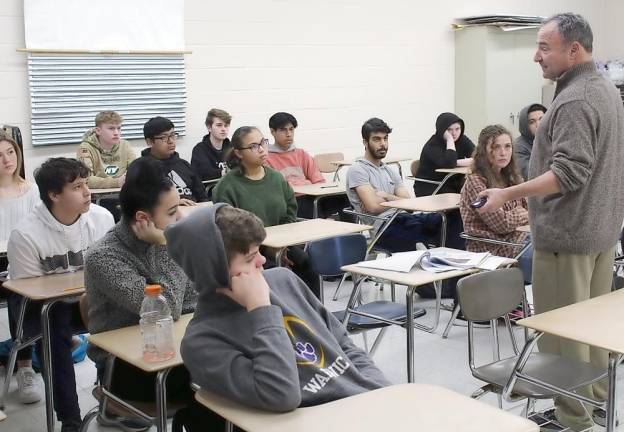Silence only gives approval
Warwick. Warwick Valley sophomores learning how to confront hateful language and actions.

As Warwick Valley High School sophomores learn more about the rise of the Holocaust and World War II in their Global History classes, they are also discussing hateful speech and tactful ways to confront such language and actions.
Michael Melasky, in a presentation titled, “Hate is Not Welcome Here,” gave a powerful account of living first-hand through the desecration of the Temple Beth Shalom Cemetery in the Village of Florida in 2016.
Vandals had spray painted anti-Semitic graffiti, just before Yom Kippur, the holiest day of the Jewish year. The cemetery had swastikas and other words and symbols spray-painted on a stone wall, which was eventually replaced.
He told the students how the devastation inspired him to educate people about tolerance, inclusion and respect for diversity.
The retired special education administrator and teacher with the Suffern School District has lived in Warwick since 1988. He learned quickly how the graffiti actually created teaching moments in the community as people stopped to see what had happened and discussed it with their family members and friends.
'It makes you ... think'
“I thought it was interesting,” sophomore Nick Cicchetti said afterward about learning of the local connection. “It was deep stuff that makes you think about what is going on in a community.”
Melasky discussed symbols of hate, such as the noose, the Confederate flag, a picture of a burning cross and the Nazi swastika. Sometimes, meanings change during history, he said.
What became the swastika symbol, he said, originated in the Neolithic Age between 10,000 and 15,000 years ago with an entirely different meaning. It symbolized peace and the movement of the sun.
He explained how Hitler utilized the symbol with the red, black and white colors to represent the German empire, how it grew to become a German nationalist symbol and eventually Jews and others who were persecuted then associated it as a symbol of hate, oppression and death.
He said the connection between history and local community events is a perfect way to lead into the Global History unit on World War II.
“A lot of what has happened during that time has impacted our community," Melasky said, "and we need to know about it.”
Confront the comment, not the person
He explained that when families and friends gather together, sometimes inappropriate words are said and they should be addressed.
“How do I respond to my loved one or friend when they say something that makes me feel uncomfortable?” he asked the students. “The hardest thing we can do is confront this behavior. It takes a lot of guts to say, ‘What you said makes me uncomfortable.’”
But silence, he said, only gives approval to the person’s action.
He recommended taking a step back from the situation, and talking to a family member or a teacher of how to address the comment.
“Don’t confront the person, confront the comment,” he said. “You could just say, ‘When you say something like that it makes me upset. I think you should think about what you said.”
“I’ve never had to confront someone before,” Cicchetti said. “It’s hard to do but it is possible, obviously. We should try.”